2001 CHRYSLER VOYAGER display
[x] Cancel search: displayPage 1163 of 4284
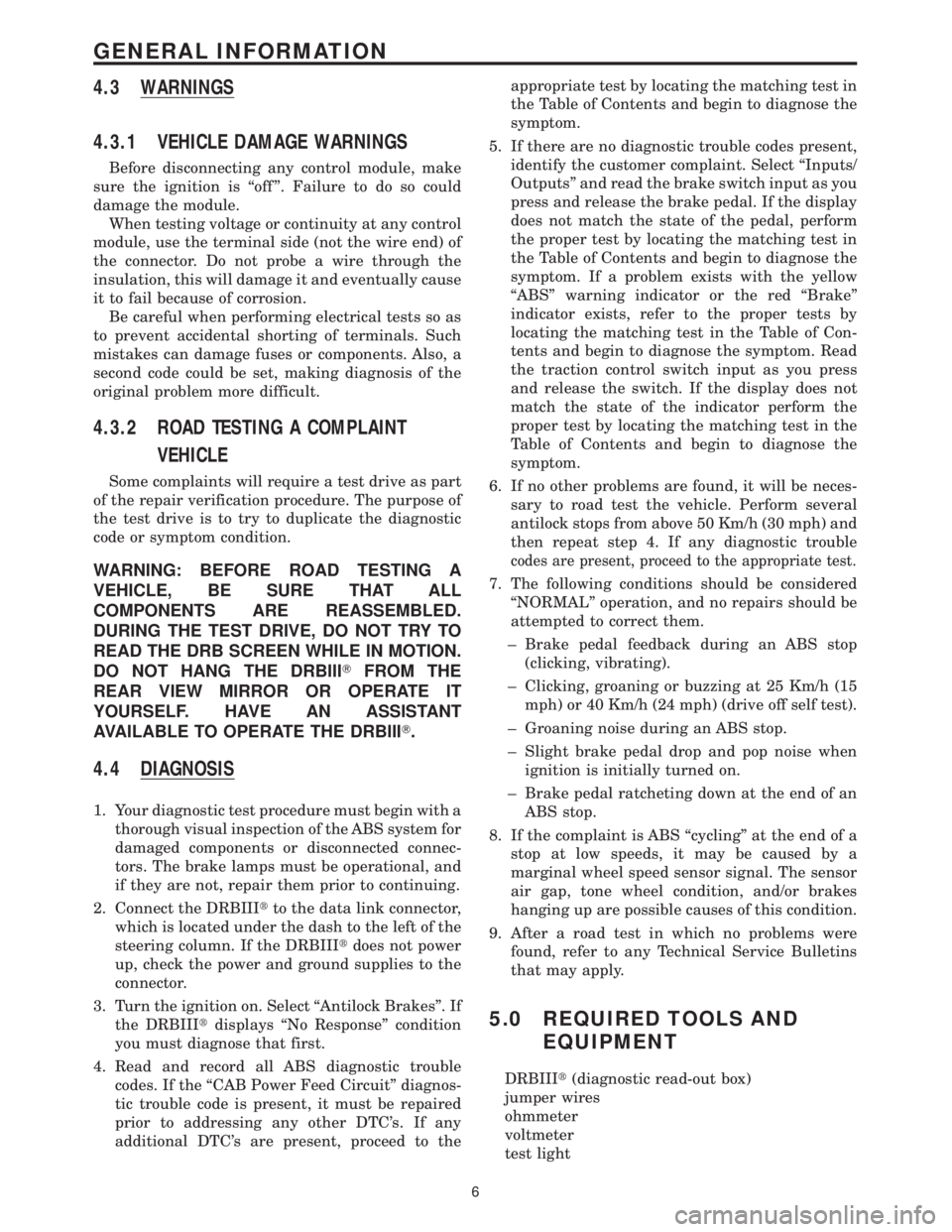
4.3 WARNINGS
4.3.1 VEHICLE DAMAGE WARNINGS
Before disconnecting any control module, make
sure the ignition is ``off ''. Failure to do so could
damage the module.
When testing voltage or continuity at any control
module, use the terminal side (not the wire end) of
the connector. Do not probe a wire through the
insulation, this will damage it and eventually cause
it to fail because of corrosion.
Be careful when performing electrical tests so as
to prevent accidental shorting of terminals. Such
mistakes can damage fuses or components. Also, a
second code could be set, making diagnosis of the
original problem more difficult.
4.3.2 ROAD TESTING A COMPLAINT
VEHICLE
Some complaints will require a test drive as part
of the repair verification procedure. The purpose of
the test drive is to try to duplicate the diagnostic
code or symptom condition.
WARNING: BEFORE ROAD TESTING A
VEHICLE, BE SURE THAT ALL
COMPONENTS ARE REASSEMBLED.
DURING THE TEST DRIVE, DO NOT TRY TO
READ THE DRB SCREEN WHILE IN MOTION.
DO NOT HANG THE DRBIIITFROM THE
REAR VIEW MIRROR OR OPERATE IT
YOURSELF. HAVE AN ASSISTANT
AVAILABLE TO OPERATE THE DRBIIIT.
4.4 DIAGNOSIS
1. Your diagnostic test procedure must begin with a
thorough visual inspection of the ABS system for
damaged components or disconnected connec-
tors. The brake lamps must be operational, and
if they are not, repair them prior to continuing.
2. Connect the DRBIIItto the data link connector,
which is located under the dash to the left of the
steering column. If the DRBIIItdoes not power
up, check the power and ground supplies to the
connector.
3. Turn the ignition on. Select ªAntilock Brakesº. If
the DRBIIItdisplays ªNo Responseº condition
you must diagnose that first.
4. Read and record all ABS diagnostic trouble
codes. If the ªCAB Power Feed Circuitº diagnos-
tic trouble code is present, it must be repaired
prior to addressing any other DTC's. If any
additional DTC's are present, proceed to theappropriate test by locating the matching test in
the Table of Contents and begin to diagnose the
symptom.
5. If there are no diagnostic trouble codes present,
identify the customer complaint. Select ªInputs/
Outputsº and read the brake switch input as you
press and release the brake pedal. If the display
does not match the state of the pedal, perform
the proper test by locating the matching test in
the Table of Contents and begin to diagnose the
symptom. If a problem exists with the yellow
ªABSº warning indicator or the red ªBrakeº
indicator exists, refer to the proper tests by
locating the matching test in the Table of Con-
tents and begin to diagnose the symptom. Read
the traction control switch input as you press
and release the switch. If the display does not
match the state of the indicator perform the
proper test by locating the matching test in the
Table of Contents and begin to diagnose the
symptom.
6. If no other problems are found, it will be neces-
sary to road test the vehicle. Perform several
antilock stops from above 50 Km/h (30 mph) and
then repeat step 4. If any diagnostic trouble
codes are present, proceed to the appropriate test.
7. The following conditions should be considered
ªNORMALº operation, and no repairs should be
attempted to correct them.
± Brake pedal feedback during an ABS stop
(clicking, vibrating).
± Clicking, groaning or buzzing at 25 Km/h (15
mph) or 40 Km/h (24 mph) (drive off self test).
± Groaning noise during an ABS stop.
± Slight brake pedal drop and pop noise when
ignition is initially turned on.
± Brake pedal ratcheting down at the end of an
ABS stop.
8. If the complaint is ABS ªcyclingº at the end of a
stop at low speeds, it may be caused by a
marginal wheel speed sensor signal. The sensor
air gap, tone wheel condition, and/or brakes
hanging up are possible causes of this condition.
9. After a road test in which no problems were
found, refer to any Technical Service Bulletins
that may apply.
5.0 REQUIRED TOOLS AND
EQUIPMENT
DRBIIIt(diagnostic read-out box)
jumper wires
ohmmeter
voltmeter
test light
6
GENERAL INFORMATION
Page 1172 of 4284
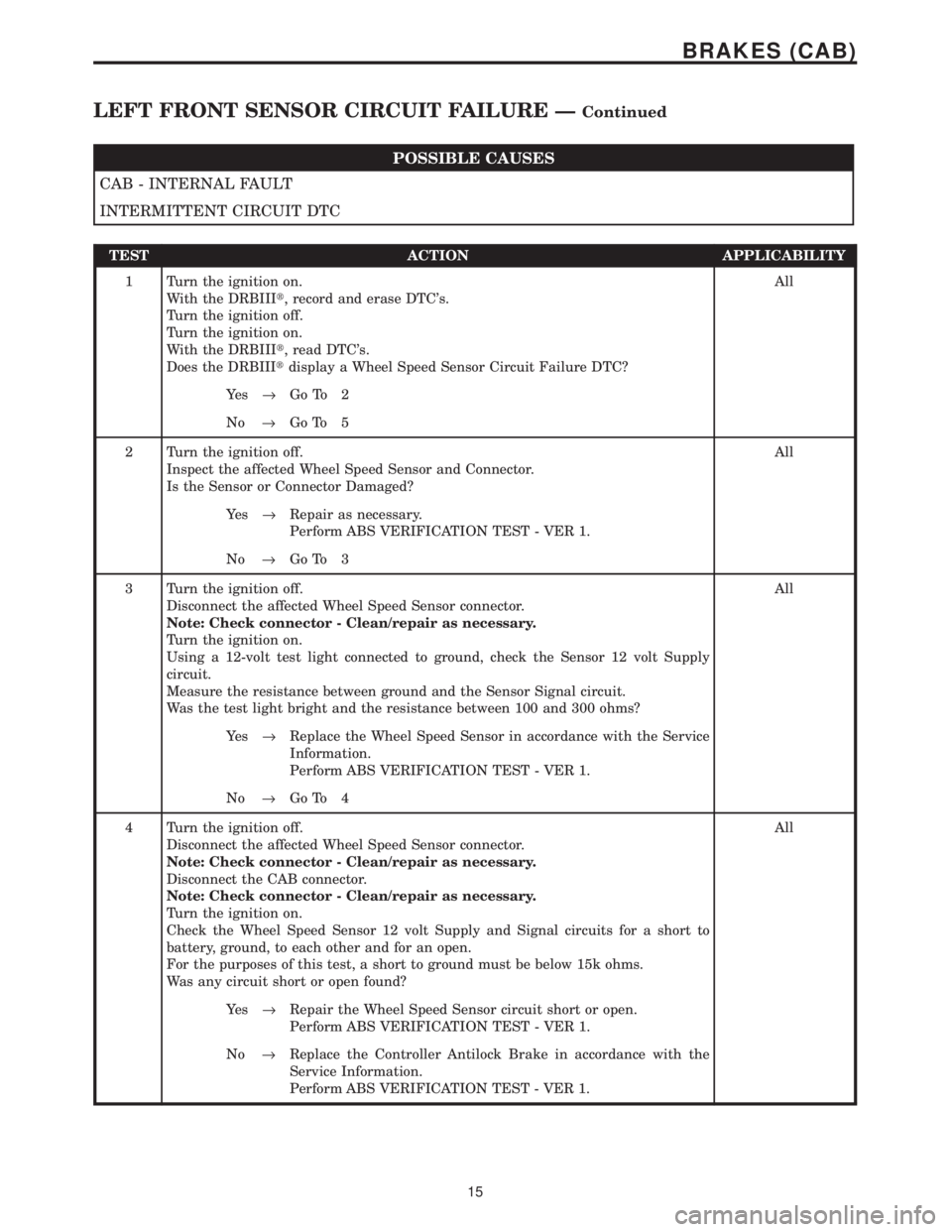
POSSIBLE CAUSES
CAB - INTERNAL FAULT
INTERMITTENT CIRCUIT DTC
TEST ACTION APPLICABILITY
1 Turn the ignition on.
With the DRBIIIt, record and erase DTC's.
Turn the ignition off.
Turn the ignition on.
With the DRBIIIt, read DTC's.
Does the DRBIIItdisplay a Wheel Speed Sensor Circuit Failure DTC?All
Ye s®Go To 2
No®Go To 5
2 Turn the ignition off.
Inspect the affected Wheel Speed Sensor and Connector.
Is the Sensor or Connector Damaged?All
Ye s®Repair as necessary.
Perform ABS VERIFICATION TEST - VER 1.
No®Go To 3
3 Turn the ignition off.
Disconnect the affected Wheel Speed Sensor connector.
Note: Check connector - Clean/repair as necessary.
Turn the ignition on.
Using a 12-volt test light connected to ground, check the Sensor 12 volt Supply
circuit.
Measure the resistance between ground and the Sensor Signal circuit.
Was the test light bright and the resistance between 100 and 300 ohms?All
Ye s®Replace the Wheel Speed Sensor in accordance with the Service
Information.
Perform ABS VERIFICATION TEST - VER 1.
No®Go To 4
4 Turn the ignition off.
Disconnect the affected Wheel Speed Sensor connector.
Note: Check connector - Clean/repair as necessary.
Disconnect the CAB connector.
Note: Check connector - Clean/repair as necessary.
Turn the ignition on.
Check the Wheel Speed Sensor 12 volt Supply and Signal circuits for a short to
battery, ground, to each other and for an open.
For the purposes of this test, a short to ground must be below 15k ohms.
Was any circuit short or open found?All
Ye s®Repair the Wheel Speed Sensor circuit short or open.
Perform ABS VERIFICATION TEST - VER 1.
No®Replace the Controller Antilock Brake in accordance with the
Service Information.
Perform ABS VERIFICATION TEST - VER 1.
15
BRAKES (CAB)
LEFT FRONT SENSOR CIRCUIT FAILURE ÐContinued
Page 1185 of 4284
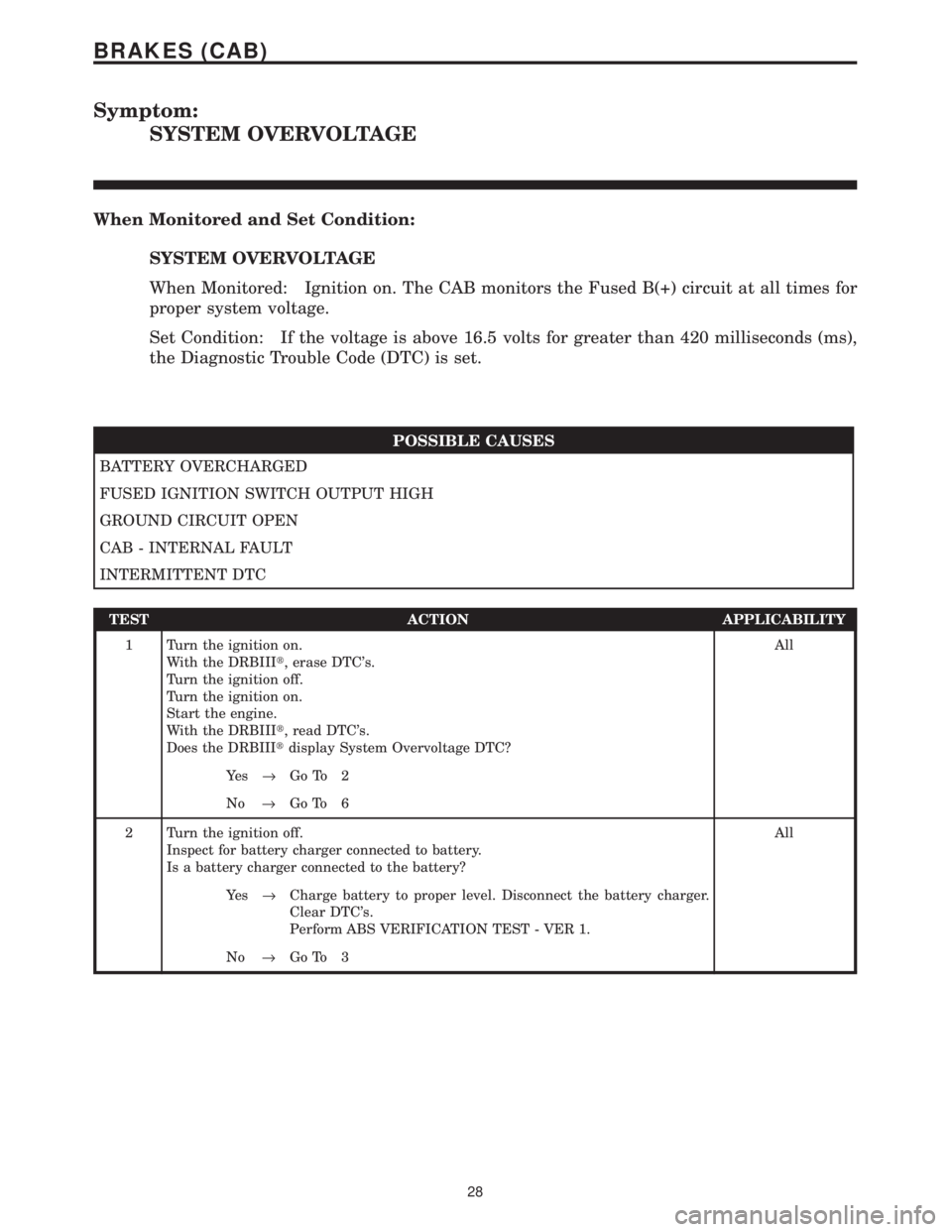
Symptom:
SYSTEM OVERVOLTAGE
When Monitored and Set Condition:
SYSTEM OVERVOLTAGE
When Monitored: Ignition on. The CAB monitors the Fused B(+) circuit at all times for
proper system voltage.
Set Condition: If the voltage is above 16.5 volts for greater than 420 milliseconds (ms),
the Diagnostic Trouble Code (DTC) is set.
POSSIBLE CAUSES
BATTERY OVERCHARGED
FUSED IGNITION SWITCH OUTPUT HIGH
GROUND CIRCUIT OPEN
CAB - INTERNAL FAULT
INTERMITTENT DTC
TEST ACTION APPLICABILITY
1 Turn the ignition on.
With the DRBIIIt, erase DTC's.
Turn the ignition off.
Turn the ignition on.
Start the engine.
With the DRBIIIt, read DTC's.
Does the DRBIIItdisplay System Overvoltage DTC?All
Ye s®Go To 2
No®Go To 6
2 Turn the ignition off.
Inspect for battery charger connected to battery.
Is a battery charger connected to the battery?All
Ye s®Charge battery to proper level. Disconnect the battery charger.
Clear DTC's.
Perform ABS VERIFICATION TEST - VER 1.
No®Go To 3
28
BRAKES (CAB)
Page 1187 of 4284
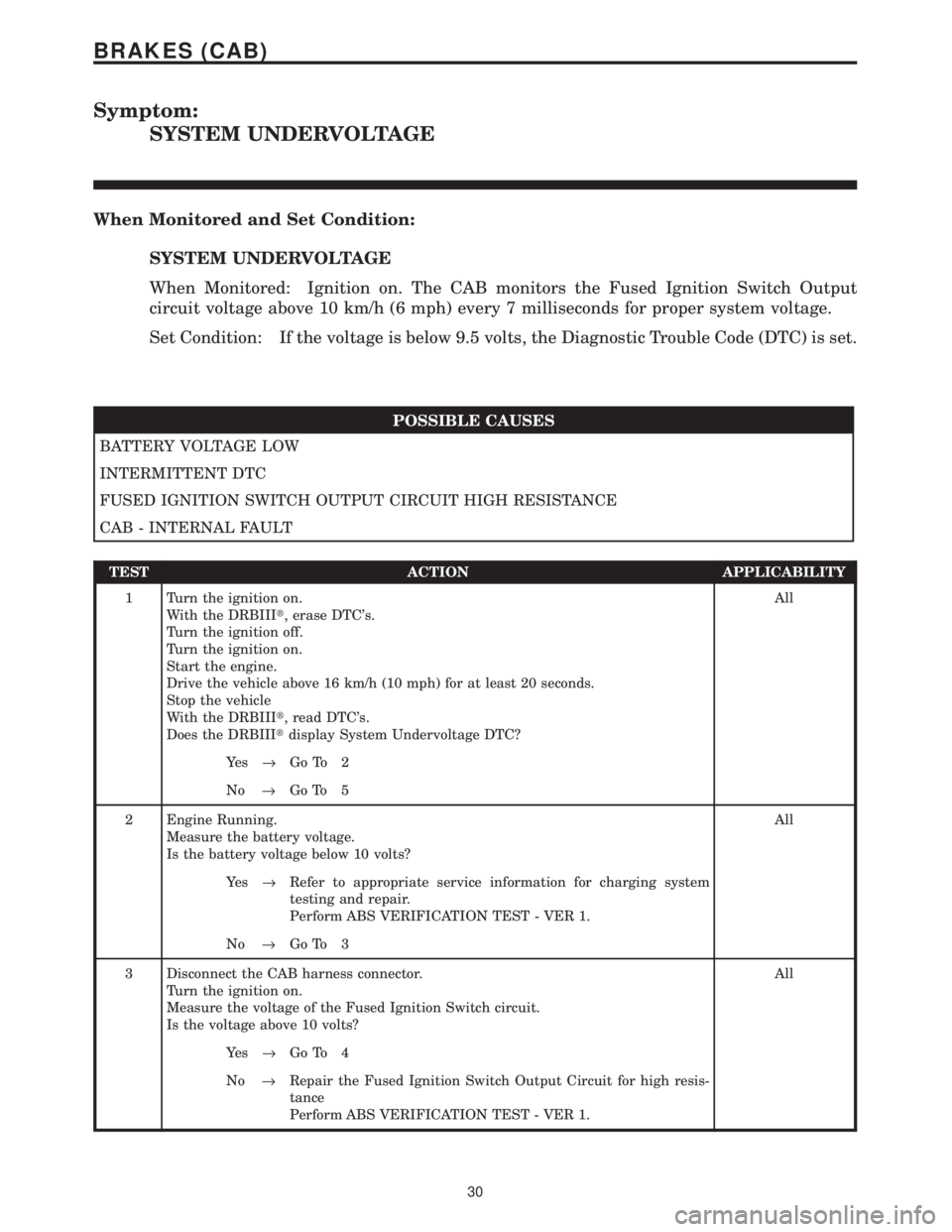
Symptom:
SYSTEM UNDERVOLTAGE
When Monitored and Set Condition:
SYSTEM UNDERVOLTAGE
When Monitored: Ignition on. The CAB monitors the Fused Ignition Switch Output
circuit voltage above 10 km/h (6 mph) every 7 milliseconds for proper system voltage.
Set Condition: If the voltage is below 9.5 volts, the Diagnostic Trouble Code (DTC) is set.
POSSIBLE CAUSES
BATTERY VOLTAGE LOW
INTERMITTENT DTC
FUSED IGNITION SWITCH OUTPUT CIRCUIT HIGH RESISTANCE
CAB - INTERNAL FAULT
TEST ACTION APPLICABILITY
1 Turn the ignition on.
With the DRBIIIt, erase DTC's.
Turn the ignition off.
Turn the ignition on.
Start the engine.
Drive the vehicle above 16 km/h (10 mph) for at least 20 seconds.
Stop the vehicle
With the DRBIIIt, read DTC's.
Does the DRBIIItdisplay System Undervoltage DTC?All
Ye s®Go To 2
No®Go To 5
2 Engine Running.
Measure the battery voltage.
Is the battery voltage below 10 volts?All
Ye s®Refer to appropriate service information for charging system
testing and repair.
Perform ABS VERIFICATION TEST - VER 1.
No®Go To 3
3 Disconnect the CAB harness connector.
Turn the ignition on.
Measure the voltage of the Fused Ignition Switch circuit.
Is the voltage above 10 volts?All
Ye s®Go To 4
No®Repair the Fused Ignition Switch Output Circuit for high resis-
tance
Perform ABS VERIFICATION TEST - VER 1.
30
BRAKES (CAB)
Page 1189 of 4284

Symptom:
VALVE POWER FEED FAILURE
When Monitored and Set Condition:
VALVE POWER FEED FAILURE
When Monitored: Ignition ON for at least 3.5 seconds. ABS Power Relay closed. Valve
command for a particular solenoid not present.
Set Condition: Low feedback voltage from the low side of all the solenoids for over 20
consecutive controller checks spaced 5 ms apart.
POSSIBLE CAUSES
INTERMITTENT DTC
BLOWN FUSE - FUSED B(+) CIRCUIT
NO B+ SUPPLY TO FUSE
FUSED B(+) CIRCUIT OPEN
B(+) CIRCUIT SHORTED TO GROUND
CAB - FUSED B(+) CIRCUIT OPEN
CAB - FUSED B(+) CIRCUIT SHORTED TO GROUND
TEST ACTION APPLICABILITY
1 Turn the ignition on.
With the DRBIIIt, erase DTC's.
Turn the ignition off.
Turn the ignition on.
Drive the vehicle above 25 km/h (15 mph) for at least 10 seconds.
Stop the vehicle.
With the DRBIIIt, read DTC's.
Does the DRBIIItdisplay Valve Power Feed Circuit DTC present right now?All
Ye s®Go To 2
No®Go To 9
2 Turn the ignition off.
Remove and Inspect the ABS Fuse 21 in the IPM.
Is the Fuse blown?All
Ye s®Go To 3
No®Go To 6
32
BRAKES (CAB)
Page 1192 of 4284
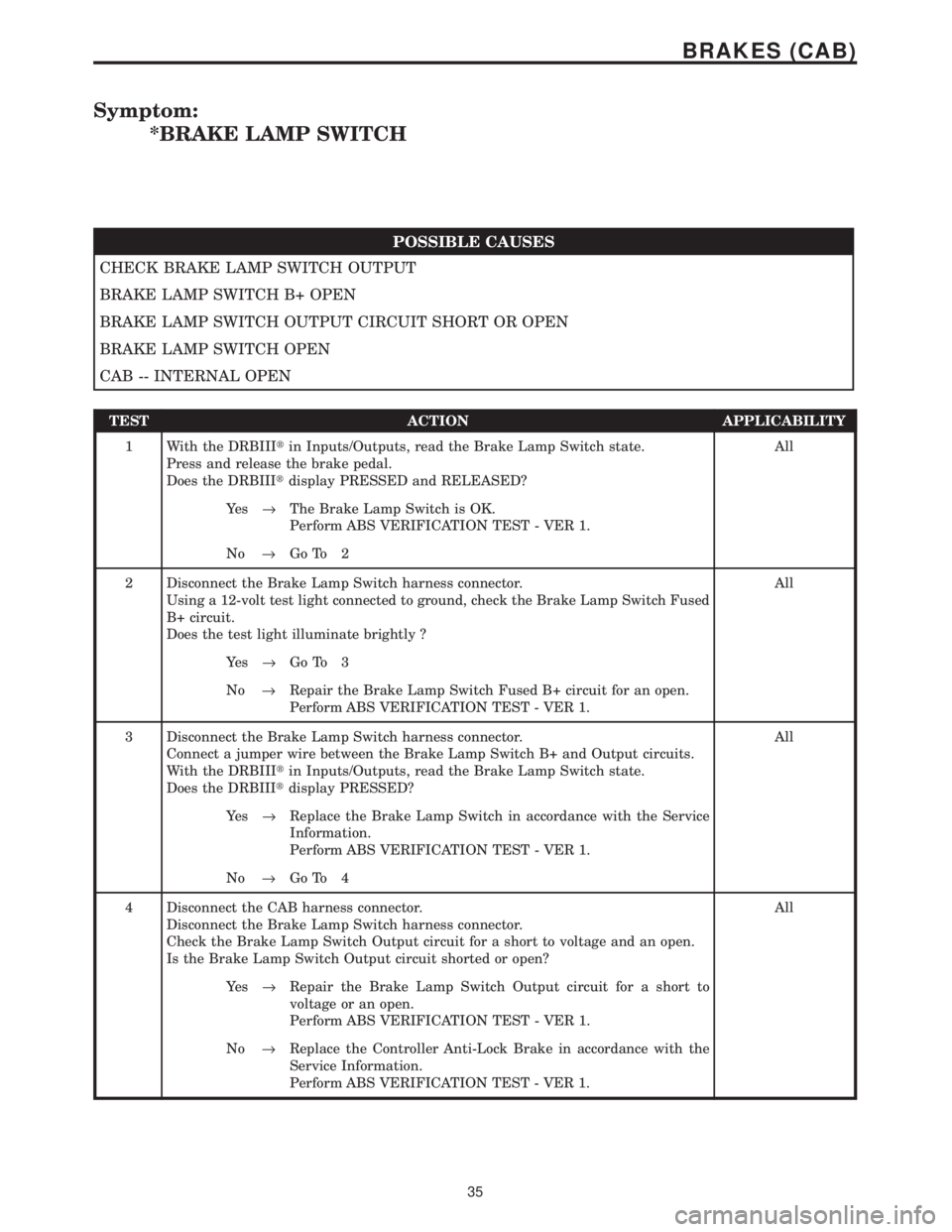
Symptom:
*BRAKE LAMP SWITCH
POSSIBLE CAUSES
CHECK BRAKE LAMP SWITCH OUTPUT
BRAKE LAMP SWITCH B+ OPEN
BRAKE LAMP SWITCH OUTPUT CIRCUIT SHORT OR OPEN
BRAKE LAMP SWITCH OPEN
CAB -- INTERNAL OPEN
TEST ACTION APPLICABILITY
1 With the DRBIIItin Inputs/Outputs, read the Brake Lamp Switch state.
Press and release the brake pedal.
Does the DRBIIItdisplay PRESSED and RELEASED?All
Ye s®The Brake Lamp Switch is OK.
Perform ABS VERIFICATION TEST - VER 1.
No®Go To 2
2 Disconnect the Brake Lamp Switch harness connector.
Using a 12-volt test light connected to ground, check the Brake Lamp Switch Fused
B+ circuit.
Does the test light illuminate brightly ?All
Ye s®Go To 3
No®Repair the Brake Lamp Switch Fused B+ circuit for an open.
Perform ABS VERIFICATION TEST - VER 1.
3 Disconnect the Brake Lamp Switch harness connector.
Connect a jumper wire between the Brake Lamp Switch B+ and Output circuits.
With the DRBIIItin Inputs/Outputs, read the Brake Lamp Switch state.
Does the DRBIIItdisplay PRESSED?All
Ye s®Replace the Brake Lamp Switch in accordance with the Service
Information.
Perform ABS VERIFICATION TEST - VER 1.
No®Go To 4
4 Disconnect the CAB harness connector.
Disconnect the Brake Lamp Switch harness connector.
Check the Brake Lamp Switch Output circuit for a short to voltage and an open.
Is the Brake Lamp Switch Output circuit shorted or open?All
Ye s®Repair the Brake Lamp Switch Output circuit for a short to
voltage or an open.
Perform ABS VERIFICATION TEST - VER 1.
No®Replace the Controller Anti-Lock Brake in accordance with the
Service Information.
Perform ABS VERIFICATION TEST - VER 1.
35
BRAKES (CAB)
Page 1196 of 4284
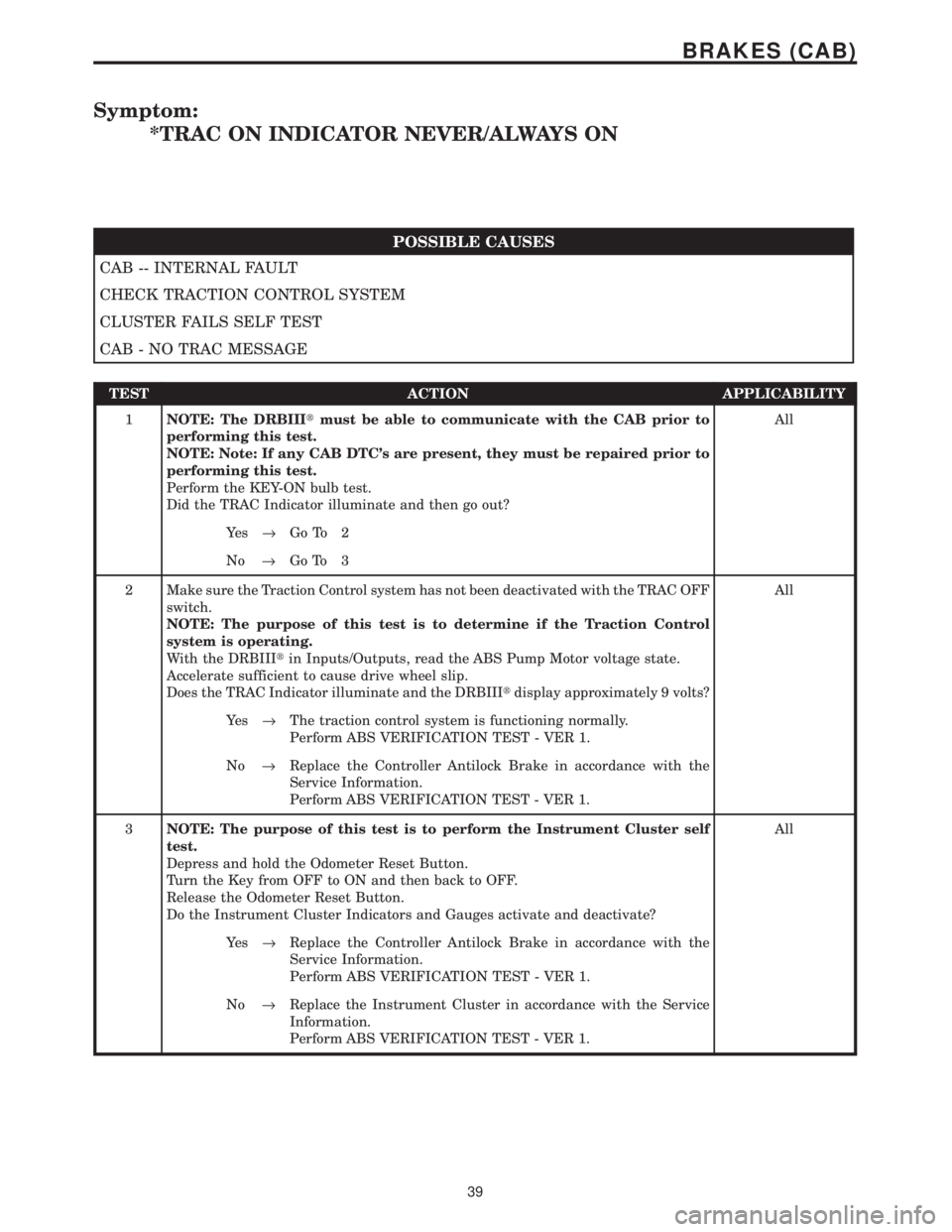
Symptom:
*TRAC ON INDICATOR NEVER/ALWAYS ON
POSSIBLE CAUSES
CAB -- INTERNAL FAULT
CHECK TRACTION CONTROL SYSTEM
CLUSTER FAILS SELF TEST
CAB - NO TRAC MESSAGE
TEST ACTION APPLICABILITY
1NOTE: The DRBIIItmust be able to communicate with the CAB prior to
performing this test.
NOTE: Note: If any CAB DTC's are present, they must be repaired prior to
performing this test.
Perform the KEY-ON bulb test.
Did the TRAC Indicator illuminate and then go out?All
Ye s®Go To 2
No®Go To 3
2 Make sure the Traction Control system has not been deactivated with the TRAC OFF
switch.
NOTE: The purpose of this test is to determine if the Traction Control
system is operating.
With the DRBIIItin Inputs/Outputs, read the ABS Pump Motor voltage state.
Accelerate sufficient to cause drive wheel slip.
Does the TRAC Indicator illuminate and the DRBIIItdisplay approximately 9 volts?All
Ye s®The traction control system is functioning normally.
Perform ABS VERIFICATION TEST - VER 1.
No®Replace the Controller Antilock Brake in accordance with the
Service Information.
Perform ABS VERIFICATION TEST - VER 1.
3NOTE: The purpose of this test is to perform the Instrument Cluster self
test.
Depress and hold the Odometer Reset Button.
Turn the Key from OFF to ON and then back to OFF.
Release the Odometer Reset Button.
Do the Instrument Cluster Indicators and Gauges activate and deactivate?All
Ye s®Replace the Controller Antilock Brake in accordance with the
Service Information.
Perform ABS VERIFICATION TEST - VER 1.
No®Replace the Instrument Cluster in accordance with the Service
Information.
Perform ABS VERIFICATION TEST - VER 1.
39
BRAKES (CAB)
Page 1214 of 4284
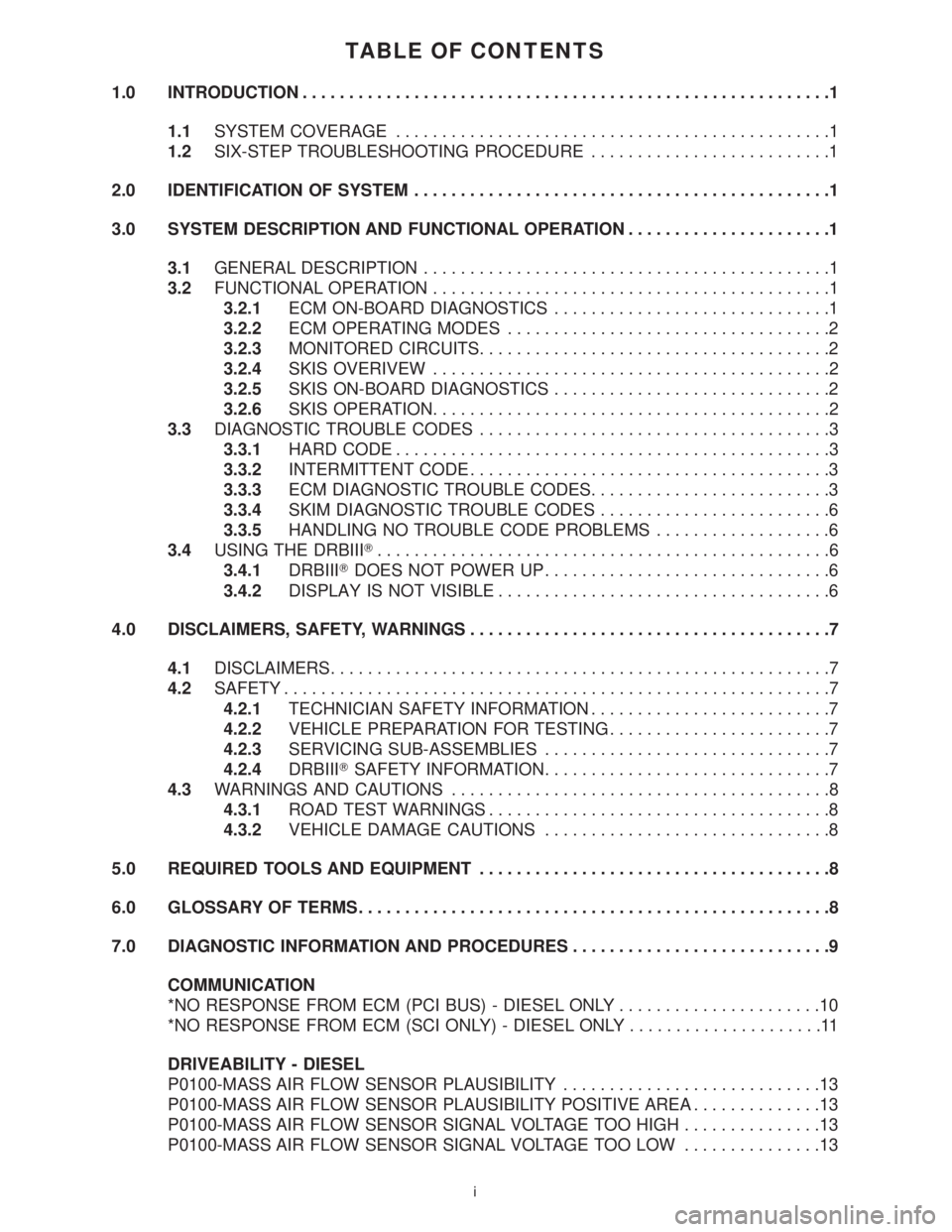
TABLE OF CONTENTS
1.0 INTRODUCTION.........................................................1
1.1SYSTEM COVERAGE...............................................1
1.2SIX-STEP TROUBLESHOOTING PROCEDURE..........................1
2.0 IDENTIFICATION OF SYSTEM.............................................1
3.0 SYSTEM DESCRIPTION AND FUNCTIONAL OPERATION......................1
3.1GENERAL DESCRIPTION............................................1
3.2FUNCTIONAL OPERATION...........................................1
3.2.1ECM ON-BOARD DIAGNOSTICS..............................1
3.2.2ECM OPERATING MODES...................................2
3.2.3MONITORED CIRCUITS......................................2
3.2.4SKIS OVERIVEW...........................................2
3.2.5SKIS ON-BOARD DIAGNOSTICS..............................2
3.2.6SKIS OPERATION...........................................2
3.3DIAGNOSTIC TROUBLE CODES......................................3
3.3.1HARD CODE...............................................3
3.3.2INTERMITTENT CODE.......................................3
3.3.3ECM DIAGNOSTIC TROUBLE CODES..........................3
3.3.4SKIM DIAGNOSTIC TROUBLE CODES.........................6
3.3.5HANDLING NO TROUBLE CODE PROBLEMS...................6
3.4USING THE DRBIIIT.................................................6
3.4.1DRBIIITDOES NOT POWER UP...............................6
3.4.2DISPLAY IS NOT VISIBLE....................................6
4.0 DISCLAIMERS, SAFETY, WARNINGS.......................................7
4.1DISCLAIMERS......................................................7
4.2SAFETY...........................................................7
4.2.1TECHNICIAN SAFETY INFORMATION..........................7
4.2.2VEHICLE PREPARATION FOR TESTING........................7
4.2.3SERVICING SUB-ASSEMBLIES...............................7
4.2.4DRBIIITSAFETY INFORMATION...............................7
4.3WARNINGS AND CAUTIONS.........................................8
4.3.1ROAD TEST WARNINGS.....................................8
4.3.2VEHICLE DAMAGE CAUTIONS...............................8
5.0 REQUIRED TOOLS AND EQUIPMENT......................................8
6.0 GLOSSARY OF TERMS...................................................8
7.0 DIAGNOSTIC INFORMATION AND PROCEDURES............................9
COMMUNICATION
*NO RESPONSE FROM ECM (PCI BUS) - DIESEL ONLY......................10
*NO RESPONSE FROM ECM (SCI ONLY) - DIESEL ONLY.....................11
DRIVEABILITY - DIESEL
P0100-MASS AIR FLOW SENSOR PLAUSIBILITY............................13
P0100-MASS AIR FLOW SENSOR PLAUSIBILITY POSITIVE AREA..............13
P0100-MASS AIR FLOW SENSOR SIGNAL VOLTAGE TOO HIGH...............13
P0100-MASS AIR FLOW SENSOR SIGNAL VOLTAGE TOO LOW...............13
i